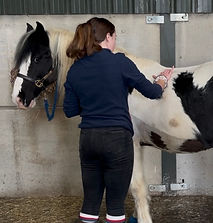top of page

GEX ANIMAL MASSAGE THERAPY
MASSAGE: THE KEY TO IT ALL...
Massage applies pressure to tissue in such a way that it causes several cellular effects to occur deep within the muscle tissue. This article further discuss' how each massage technique will help improve your animals performance.
GRACIE EXLER | 17 JUNE 2025

EFFLEURAGE
Effleurage is one of the most common techniques used by therapists as it simply prepares the muscle before the application of deeper techniques. It helps to warm the targeted muscle area, relieves tight muscles, kickstarts relaxation and helps flush out waste product etc after massage has been applied. This technique involves light pressured strokes which are long and slow. Deep effleurage can then be applied to reach further into the muscle.
COMPRESSION
Compression is an interesting technique and has proven to be very effective. It causes a process known as 'capillary reflux', when pressure is applied and held on the muscle it causes the blood and fluid to be pushed out of the targeted area. Once this pressure has been released there is reduced blood flow, oxygen and nutrients (all of which are crucial for healthy muscles). The body then responds by increasing blood flow to the area meaning the muscles receive a fresh supply of oxygen and nutrients, thereby boosting the health of the muscle.


CROSS FIBRE FRICTION
Cross fibre friction is one of the deepest massage techniques and is particularly great if the animal has some scar tissue. Cross fibre friction is where pressure is applied across the muscle fibre direction which leads to an increase in blood flow and nutrients. It also helps re-boot the healing process that injuries undergo by causing a small amount of inflammation. This allows the muscle fibre orientation to go from disorganised to a straight parallel orientation. To achieve this effleurage and stretching should be applied.
TAPOTEMENT
Tapotement, the multitasking massage technique! This technique can be used for two different effects, one which stimulates the muscles to awaken then and the other to enhance lymphatic drainage.The way in which it stimulates muscles is that the nerve detects striking of the muscle and relays this information to the motor neuron (which controls muscle contraction). This causes the muscle to awaken and maintain its tone, which makes it great for animals which have muscle wastage. On the other hand it works as a pump for the lymphatic system and works to push this fluid towards lymph nodes to help filter waste product.

PIEZOELECTRIC EFFECT
Massage encourages type I collagen (organised structure) and sodium/potassium which enhances cell performance. This helps improve cell repair and increase cell production.
CIRCULATORY EFFECT
When massage applies pressure to tissue it increases histamine production. Once this increase has been recognised, bradkykinin (hormone) gets released. This works to widen blood vessels to improve blood flow to the area.
ANALGESIC EFFECT
This process involves nerve fibres which transmit pain signals to the brain. Massage releases a specific nerve fibre (a-beta) which works to block pain signals from reaching the brain allowing the animal to feel relaxed whilst offering pain relief.
REFERENCES
Riley, L.M., Satchell, L., Stilwell, L.M., Lenton, N.S., (2021) 'Effect of massage therapy on pain and quality of life in dogs: A cross sectional study', Veterinary Record, 189(11).
Scott, M., Swenson, L.A., (2009) 'Evaluating the benefits of equine massage therapy: A review of the evidence and current practices', Journal of equine veterinary science, 29(9), pp. 687-697.
Weerapong, P., Hume, P.A., Kolt, G.S., (2005) 'The mechanisms of massage and effects on performance, muscle recovery and injury prevention', Sports medicine, 35(3), pp. 235-256.
bottom of page